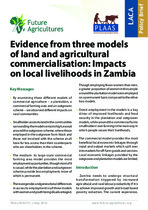| dc.contributor.author | Matenga, Chrispin Radoka | |
| dc.contributor.author | Hichaambwa, Munguzwe | |
| dc.date.accessioned | 2019-03-01T11:16:55Z | |
| dc.date.available | 2019-03-01T11:16:55Z | |
| dc.date.issued | 2016 | |
| dc.identifier.citation | Hichaambwa, M. et al. (2016). Evidence from three models of land and agricultural commercialisation: Impacts on local livelihoods in Zambia. Policy Brief 83, Bellville: Institute for Poverty, Land and Agrarian Studies, University of the Western Cape | en_US |
| dc.identifier.uri | http://hdl.handle.net/10566/4318 | |
| dc.description.abstract | Zambia needs to undergo structural transformation triggered by increased agricultural and rural labour productivity if it is to achieve improved growth and broad-based poverty reduction. The current experience, however, is far from the radical change needed in order to achieve this. Zambia’s agricultural sector is characterised by a large number of poor smallholders contributing most of agricultural output, with low yields, limited commercialisation and few signs of rapid productivity growth. | en_US |
| dc.language.iso | en | en_US |
| dc.publisher | Institute for Poverty, Land and Agrarian Studies, University of the Western Cape | en_US |
| dc.relation.ispartofseries | Policy Brief: Future Agricultures Consortium;83 | |
| dc.subject | Zambia | en_US |
| dc.subject | Plantation | en_US |
| dc.subject | Commercial farming | en_US |
| dc.subject | Outgrower scheme | en_US |
| dc.subject | Employment | en_US |
| dc.title | Evidence from three models of land and agricultural commercialisation: Impacts on local livelihoods in Zambia | en_US |
| dc.type | Other | en_US |

